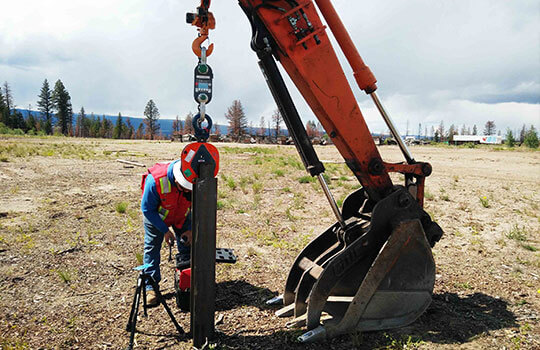
Utility-scale and large commercial ground- mounted solar systems are becoming more common in Western Canada. One of the challenges solar projects developers are facing is the unknown of the ground conditions, resulting in the uncertainty in the foundation design and overall project costs. Let us walk you through what a proper testing program for a solar farm looks like.Upon selection of the land where development will occur, a Test Plan shall be prepared. The said plan shall include details as to what extend of investigation is required in order to determine precise geotechnical factors and foundation type suitable for that location. Test plan extent is based on location characteristics – size, surficial geology, orography and topology.Testing plan shall be based on two critical aspects, geotechnical and pile testing.Geotechnical investigation shall account for the following parameters:
- Soil type classification – ASTM D2487,
- Atterberg limits – Geotechnical Testing Journal Volume 36 Issue 6.
- Particle size distribution (Gradation) of soils using sieve analysis – Standard ASTM D6913.
- Friction angle or cohesion – ASTM D5321,
- Resistance factors for the different layers of soil (SPT / soil sampling) – ASTM D1586
- Corrosion considerations (resistivity / PH) – ASTM G57. Depending on how corrosive the ground is and the life cycle of the project, engineers will determine materials requirements.
- Addfreeze and frost penetration depth (historic weather correlation studies / Percolation / water table) – ASTM E2242. Frost heave of the foundation is one of the main design parameters to consider; frost action extent will be determined by many factors, some of the most important ones have to do with moist / water content.
- Pit excavation to determine any potential constraints during construction. Soil stability is a relevant piece of information in the event that any excavation / pre-drilling is required for the foundation.
Parallel to the geotechnical / soil testing plan, a pile testing plan shall be prepared as well. This plan shall target the two most relevant factors for a ground-mounted solar system foundation design:
- Tension / pullout capacity – ASTM D3689, in order to determine if selected design will withstand the add freeze loads.
- Lateral capacity – ASTM D3966, in order to determine if selected design is suitable for expected lateral loads / moments.
The pile test plan shall include, tests quantities, which depends largely on the size of the site and the geotechnical investigation. A few things to consider are:
- Test loads shall be calculated using design loads for the super-structure (assembled racking and modules). The test loads are not necessarily have to be the same across the site. Once test loads have been determined, properly rated testing equipment shall be selected. In case it is not feasible to reach ultimate loads, a Davisson method can be used for extrapolation testing results.
- Test piles embedment depth can be determined based on the geotechnical investigation that has been carried out.
- Axial compression test is not recommended for ground-mounted solar systems due to the minimal weight of a solar panel.
- Lateral test will not provide deflection factors for the foundation material, that information can be gathered from manufacturers specification.
This information from geotechnical and tile testing will allow engineers to determine the most suitable and foundation for your project along with any civil (earthwork) requirements. Solar Plantation Inc is able to help with an optimal foundation design, including a Testing Plan similar to what’s been described in this article along with loading information based on the racking characteristics and wind / snow loads.
 Utility-scale and large commercial ground- mounted solar systems are becoming more common in Western Canada. One of the challenges solar projects developers are facing is the unknown of the ground conditions, resulting in the uncertainty in the foundation design and overall project costs. Let us walk you through what a proper testing program for a solar farm looks like.Upon selection of the land where development will occur, a Test Plan shall be prepared. The said plan shall include details as to what extend of investigation is required in order to determine precise geotechnical factors and foundation type suitable for that location. Test plan extent is based on location characteristics – size, surficial geology, orography and topology.Testing plan shall be based on two critical aspects, geotechnical and pile testing.Geotechnical investigation shall account for the following parameters:
Utility-scale and large commercial ground- mounted solar systems are becoming more common in Western Canada. One of the challenges solar projects developers are facing is the unknown of the ground conditions, resulting in the uncertainty in the foundation design and overall project costs. Let us walk you through what a proper testing program for a solar farm looks like.Upon selection of the land where development will occur, a Test Plan shall be prepared. The said plan shall include details as to what extend of investigation is required in order to determine precise geotechnical factors and foundation type suitable for that location. Test plan extent is based on location characteristics – size, surficial geology, orography and topology.Testing plan shall be based on two critical aspects, geotechnical and pile testing.Geotechnical investigation shall account for the following parameters: